(EATC file) 167 aircraft on hand
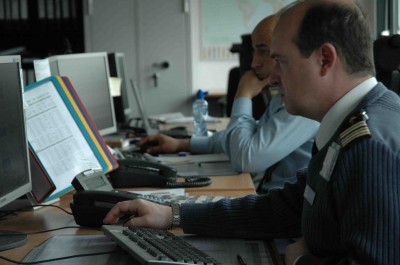
(BRUXELLES2 to Eindhoven) The civil airport on one side; the military airport on the other. Upstairs, the EATC operations room. The holy of holies. On the large screens on the wall scroll the most exotic destinations (Bamako, Tripoli…) as well as the most classic (Lorient, Toulouse, Pristina Kfor). Here, teams of 12 people follow each other in 4-hour increments (one shift) who are able to " fulfill the various functions devolved to the EATC (planning, tasking, controlling, reporting and medical support) explains the commander of the operational division, the Dutch colonel Jurgen van den Biezen. The types of mission vary: from the simple transport of equipment, to the exercise of dropping paratroopers, to the transfer of troops to the various theaters (Afghanistan, Kosovo, etc.) and the evacuation of citizens (as in Libya recently).
In the room, four officers, four functions
The principle of the mission is classic. A request message is received which is transmitted to the movement centre. The duty officer receives, plans the request, controls the execution of the mission. Finally, a report (the reporting) is made which is returned to the participating States. In Eindhoven, we receive the message: we check if the requested means is available, we produce the mission order, we check and verify that the mission is executed, after the mission we make the report and we analyze the missions."

On the wall, the world scrolls
A spreadsheet brings together – in real time – all the necessary information: type of aircraft, registration, take-off and landing times, destination, cargo, number of people, etc., including the name of the captain. Small acronyms (blue, green, orange, etc.) symbolize the status of the mission (in preparation, ready for takeoff, in flight, completed). Other spreadsheets allow you to know for each aircraft, the flight hours, the technical problems encountered, the interviews to be carried out, etc.
in-house software
For this, it was necessary to build a computer system for the 4 nations. It was first fully implanted in the Germans and Dutch. For the French, it took a little longer because it was necessary to equip each of the French and overseas operational bases with this software, to have all the information in real time. With the Belgians, there was a " Technical problem " (transmissions and connectivity), until recently, which has been settled recently.
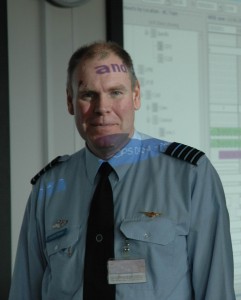
The 4 stages of a mission
1) The “schedule”. The most important thing is to prioritize messages, according to demand (people, cargo, etc.) and to maximize travel, making stopovers if necessary. The State has two choices: either keep the mission national, or ask EATC to carry out the national mission. The message normally comes from the center of movements (military). For the repatriation of citizens, this generally comes from the Minister of Defence.
2) Tasking. It is necessary to prepare the mission: the duration of the flight, the route, the necessary means on site. EATC has two sections, one in charge of tactical flights (“khaki” flights), the other non-tactical flights (white planes and strategic flights).
3) Control. The maintenance man is also important for providing the necessary logistical means, solving possible maintenance problems, pre-positioning the necessary means, loading containers, etc.
4) Medical Air Evacuation CC (AECC): training of doctors and surgeons, to have a team permanently available 24 hours a day. " If we have a transport request for a patient, for example for Afghanistan, there are specific planes that can be used for repatriation. The idea, here too, is to avoid taking a civilian plane, when a military plane passes by ».
Funding
The distribution of the financial burden is still made according to the Atares system, the exchange which brings together 27 nations. The role of EATC in this case is to " monitor these exchanges, to avoid budgetary slippage ". In the future, it is not excluded to review this device - explains Ltc Monard - " to have a more integrated system than Atares which remains, in itself, quite brief.
A term hub
In Eindhoven, at EATC HQ, there are no planes parked under the windows of the headquarters. The planes remain on their departure base. Creil, Evreux, Orléans, Mont de Marsan, French side; Hohn, Wunstorf, Köln and Landsberg on the German side, Eindhoven for the Dutch and Melsbroek (Brussels) on the Belgian side (see map). Because " that's where the support is. But we can start a plane from Paris to load in Köln and then go back to Afghanistan ". Eventually, we hope to be able to work in hub ».
First assessment
In a few months of operation, between October 15 and the end of February, EATC has already carried out more than 2000 missions, including 1400 for the Germans, nearly 550 for the French and 100 for the Dutch (figures as of February 28). It totals more than 13.000 flight hours, with a clear difference between German flights (about 5 hours per flight) and French or Dutch flights (about 8 hours per flight). It transported 66.600 passengers, 144 Medevac (medical evacuations, 83 for the Germans, 60 for the French and 1 for the Dutch), 3.300 tons of freight and provided 42 in-flight refueling missions (mainly for the Dutch and Germans).
To his credit, also some successes such as the repatriation of European citizens to Arab countries, in particular to Libya.
* * *
The fleet: 167 aircraft
- The fleet includes 167 aircraft out of the 257 available in the 4 countries. A little less than half of the French fleet (57 out of 130 planes), 80% of the German fleet (82 out of 100 planes), all of the Belgian (19 planes) and Dutch (8 planes) fleets.
- Tactical aircraft (khakis): 25 C-130s (11 Belgians, 10 French, 4 Dutch), 110 C-160s (36 French and 73 Germans + 1 medic*), 9 Casa 235 (French),
- Strategic aircraft (white): 9 Airbus A-310 (1 Belgian, 3 French, 4 German + 1 medical *), 2 Airbus A340 (French), 2 KDC 10 (Dutch), 4 CL 601 (German *, 2 Airbus A319 (German), 1 DC10 (Dutch)
- 1 Gulfstream (Dutch), 4 Embraer (2 ERJ 135 and 2 Belgian), 145 Falcon (3 Belgian Falcon 2 and 20 Falcon 1).
- (*) These planes remain under German OpCon, but they are available to EATC in particular for medical evacuations.

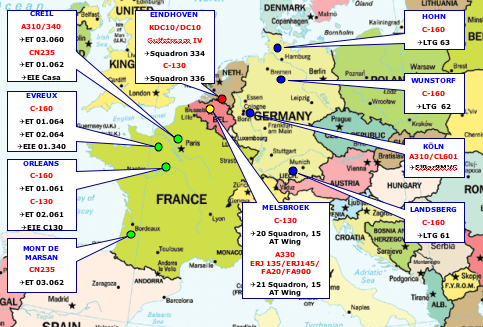
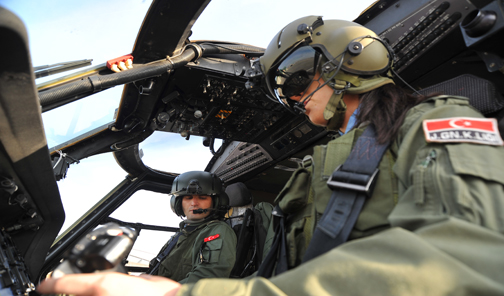
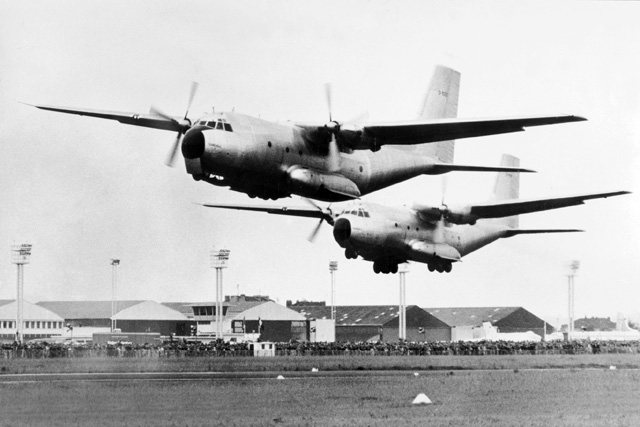
Comments closed.